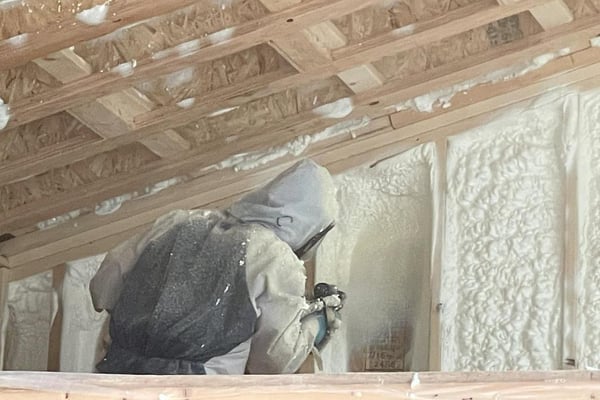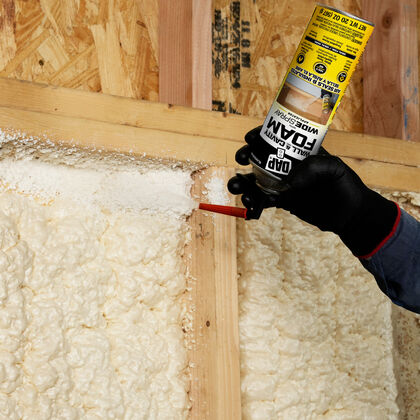Recognizing the Benefits of Using Spray Foam for Insulation Projects
Recognizing the Benefits of Using Spray Foam for Insulation Projects
Blog Article
Spray Foam: The Ultimate Service for Air Sealing and Insulation
Spray foam insulation has arised as a leading service for efficient air sealing and thermal insulation, supplying an unique mix of properties that establish it apart from traditional methods. Understanding the complete range of its advantages, installation procedures, and comparisons with other insulation kinds is critical for making informed choices.
What Is Spray Foam?
Spray foam is a functional insulation product that integrates the concepts of air securing and thermal resistance to enhance power performance in buildings. Composed largely of polyurethane or other similar substances, spray foam is applied as a liquid that broadens upon call with surface areas, creating a strong, continuous layer of insulation. This distinct property enables it to load gaps, splits, and gaps that typical insulation materials may overlook, supplying an exceptional air seal.
There are two major kinds of spray foam: open-cell and closed-cell. Open-cell spray foam is lighter and much more versatile, offering excellent audio absorption and a reduced R-value per inch - Spray Foam. In contrast, closed-cell spray foam is denser, providing a greater R-value, dampness resistance, and included structural honesty to developing elements
The application procedure usually entails specific devices, making sure a seamless application that sticks to various substratums, including wood, metal, and concrete. This adaptability makes spray foam ideal for both new building and constructions and retrofitting existing structures. Its capability to develop a closed obstacle considerably contributes to minimizing energy usage and enhancing interior air quality, thereby making it a recommended choice among home builders and property owners alike.
Advantages of Spray Foam Insulation
One of the most significant benefits of spray foam insulation is its outstanding capacity to create a continuous air obstacle, which successfully decreases power loss. Unlike standard insulation products, spray foam expands to load spaces and splits, making sure that air leakage is substantially lowered. This characteristic not just boosts power performance however also brings about decrease utility expenses over time.
In addition, spray foam insulation provides exceptional thermal resistance, adding to a much more steady interior environment. Its high R-value per inch enables efficient insulation in restricted spaces, making it suitable for attic rooms, wall surfaces, and crawl rooms. The moisture-resistant homes of spray foam help prevent mold and mildew growth, advertising healthier living problems.
One more crucial advantage of spray foam insulation is its sound-dampening qualities (Spray Foam). It properly minimizes sound transmission in between rooms, producing a quieter and a lot more comfortable home setting. The toughness of spray foam also attracts attention, as it does not sag or work out with time, maintaining its performance throughout its lifespan
Just How Spray Foam Works
Recognizing how spray foam insulation works is vital for valuing its performance in air securing and thermal resistance. Spray foam insulation includes two key components: isocyanate and polyol material. When these parts are mixed, they undergo a chain reaction that causes the product to broaden swiftly, creating a dense foam that loads fractures, voids, and cavities.
As the foam expands, it follows surfaces, creating an airtight seal that substantially reduces air seepage. This particular makes spray foam insulation highly efficient at protecting against drafts and wetness penetration, which can result in energy loss and damage over time. In addition, the closed-cell version of spray foam offers premium thermal resistance due to its rigid structure, successfully lessening warmth transfer.
The special properties of spray foam permit it to satisfy irregular surfaces, making sure thorough insurance coverage and a smooth obstacle. Because of this, spray foam insulation not only enhances energy performance however likewise adds to improved indoor air high quality by minimizing the build-up of allergens and toxins. Inevitably, understanding the auto mechanics behind spray foam underscores its duty as an exceptional choice for insulation and air sealing in both industrial and residential applications.
Installment Refine Review

Before installment, the area should be adequately cleaned and prepped, guaranteeing that surface areas are without moisture, dust, and particles. learn this here now Because pollutants can compromise adhesion and overall efficiency, this step is important. When the location is prepared, the application includes blending the 2 components of the spray foam, which expands upon contact and fills voids successfully.
Educated experts should carry out the setup, utilizing specific equipment to make sure uniform insurance coverage and optimal thickness. Safety safety measures, including putting on safety gear and guaranteeing appropriate air flow, are here are the findings important during this procedure. After application, the foam typically remedies swiftly, developing a strong obstacle that boosts energy effectiveness.
Contrasting Spray Foam to Standard Insulation
When evaluating insulation alternatives, spray foam insulation stands out in contrast to traditional products such as fiberglass and cellulose. Unlike fiberglass and cellulose, which can allow air infiltration, spray foam increases upon application, filling up gaps and crevices to develop an impermeable seal.
Furthermore, spray foam offers a greater R-value per inch than conventional insulation types, using even more efficient thermal resistance in a thinner profile. This characteristic is specifically valuable precede with limited cavity depth. Moreover, spray foam is resistant to wetness and mold and mildew development, which can be a substantial worry with cellulose and fiberglass, particularly in damp environments.
Nevertheless, spray foam insulation usually brings a greater ahead of time cost than its typical counterparts. Homeowners have to evaluate this preliminary financial investment versus long-lasting energy cost savings and performance benefits. Ultimately, while both insulation types serve their purpose, spray foam becomes a more sophisticated remedy for contemporary insulation requirements, particularly in regards to air sealing and thermal performance.

Final Thought
In summary, spray foam insulation represents an extremely reliable remedy for achieving ideal air securing and thermal resistance. Its distinct properties, consisting of wetness resistance and sound dampening, make it have a peek at this website suitable for different applications in both new buildings and retrofitting jobs (Spray Foam). Although the initial costs might be higher compared to traditional insulation materials, the lasting advantages, such as substantial energy cost savings and improved indoor air high quality, justify the investment and emphasize its worth in modern-day building practices.
Spray foam insulation has actually arised as a leading option for reliable air securing and thermal insulation, providing a distinct combination of residential properties that set it apart from standard techniques.Spray foam is a functional insulation material that incorporates the concepts of air sealing and thermal resistance to enhance power effectiveness in buildings.When examining insulation options, spray foam insulation stands out in comparison to traditional materials such as fiberglass and cellulose. Inevitably, while both insulation kinds serve their function, spray foam arises as a more advanced service for modern-day insulation requirements, particularly in terms of air sealing and thermal performance.
In recap, spray foam insulation represents a highly efficient option for achieving ideal air sealing and thermal resistance.
Report this page